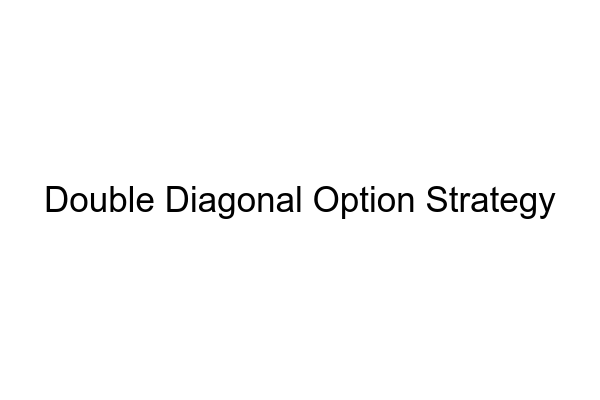Double Diagonal Option Strategy

What are the characteristics of this option strategy?
The Double Diagonal Option Strategy is a complex options strategy that combines both diagonal spreads and vertical spreads to exploit market volatility. It’s a neutral option strategy that involves the purchase and sale of multiple options with different strike prices and different expiration dates. The purpose of the Double Diagonal Option Strategy is to take advantage of the tendency of stocks and indices to see significant price movement within a particular period of time.
Is this a bullish, bearish or neutral strategy?
The Double Diagonal Option Strategy is a neutral strategy, as it is designed to take advantage of price movement regardless of which direction the stocks or indices move. It is, however, possible to use the strategy in a bullish or bearish manner.
Is this a beginner or an advanced option strategy?
The Double Diagonal Option Strategy is generally considered to be an advanced option strategy, as it involves the purchase and sale of multiple options and is best executed with a good understanding of market volatility and the Greeks.
In what situation will I use this strategy?
The Double Diagonal Option Strategy is usually used when there is a high likelihood of a sharp price movement within a particular period of time. When markets are relatively calm, the Double Diagonal Option Strategy is not ideal, as it is likely to produce minimal profits.
Where does this strategy typically fall in the range of risk-reward and probability of profit?
The Double Diagonal Option Strategy typically falls in the range of moderate to high risk-reward, with a high probability of profit. Due to the multiple options involved in this strategy and the complex nature of the trades, the risk of an adverse move is higher than with more basic strategies.
How is this strategy affected by the greeks?
This strategy is heavily affected by the greeks, as the multiple options involved result in significant exposure to the greeks. The main greeks that affect this strategy are Delta, Gamma, Theta, and Vega.
In what volatility regime (i.e VIX level) would this strategy be optimal?
The Double Diagonal Option Strategy is typically most effective when the VIX is at a relatively high level. When volatility is low, the strategy is likely to produce minimal profits.
How do I adjust this strategy when the trade goes against me? And how easy or difficult is this strategy to adjust?
Adjusting this strategy when the trade goes against you can be difficult, as the multiple options involved require careful attention. If possible, the optimal solution is to close out the losing position. If it is necessary to adjust the trade, the adjustments need to be carefully calculated to ensure that the risk remains consistent with the original strategy.
Where does this strategy typically fall in the range of commissions and fees?
The Double Diagonal Option Strategy typically falls in the range of medium to high commissions and fees. This is due to the multiple option trades involved and the complexity of the strategy.
Is this a good option income strategy?
The Double Diagonal Option Strategy is primarily used as a speculative strategy and not a good option income strategy. As the profits are typically modest in size, it is not an ideal strategy for generating regular income.
How do I know when to exit this strategy?
Exiting this strategy depends on the trader’s risk tolerance level and overall market conditions. The general rule is to exit when the profits are no longer sufficient to justify the risk of the trade.
How will market makers respond to this trade being opened?
Market makers will usually respond to this trade by adjusting option premiums and gamma levels. This is due to the complexity of the strategy and the relatively higher levels of risk involved.
What is an example (with calculations) of this strategy?
A basic example of the Double Diagonal Option Strategy would be as follows: The investor purchases a call option of MSFT with a strike price of $275 and a long-term expiration date while also selling a call option with a strike price of $280 and a short-term expiration date. The investor hopes to benefit from a sharp price move in either direction within the defined period. If the stock moves up significantly, the short-term option will be in the money. However, the investor will still benefit from the value of the long-term option. Similarly, if the stock moves down significantly, the investor will benefit from the short-term option being out of the money. Similarly, the investor purchases a put option of MSFT with a strike price of $255 and a long-term expiration date while also selling a put option with a strike price of $250 and a short-term expiration date, making it a double diagonal spread. This way, the investor can benefit of sharp movement on either sides.
MarketXLS.
MarketXLS is a powerful stock analysis tool that can help you take advantage of the Double Diagonal Option Strategy. It allows investors to quickly analyze options and calculate the risk-reward and probability of the strategy. It also allows investors to quickly perform sophisticated adjustments when the trade goes against them. By placing their trades directly from MarketXLS, investors can save time and money and maximize their chances of profiting from the Double Diagonal Option Strategy.
Here are some templates that you can use to create your own models
Search for all Templates here: https://marketxls.com/templates/
Relevant blogs that you can read to learn more about the topic
Double Diagonal Option Strategy
Double Diagonal Option Strategy
Leverage Vega to Maximize Your Option Gains
